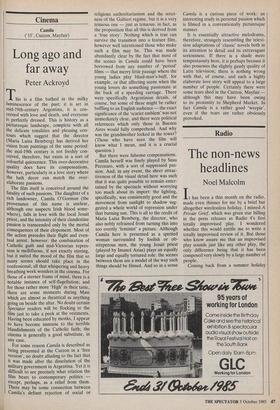Cinema
Camila ('15', Curzon, Mayfair)
Long ago and far away
Peter Ackroyd
This is a film bathed in the milky luminescence of the past; it is set in mid-19th-century Argentina, it is con- cerned with love and death, and everyone is perfebtly dressed. This is history as a picturesque landscape, complete with all the delicate tonalities and pleasing con- tours which suggest that the director (Maria Luisa Bemberg) has derived her vision from paintings of the same period: the mid-19th century is not freshly con- ceived, therefore, but exists in a sort of colourful quiescence. This over-decorative quality does have its compensations, however, particularly in a love story where the lush decor can match the over- elaborate passions.
The film itself is conceived around the fatality of such passions. The daughter of a rich landowner, Camila O'Gorman (the provenance of this name is unclear, although one suspects Irish blood some- where), falls in love with the local Jesuit priest, and the intensity of their clandestine passion is transcended only by the mortal consequences of their elopement. Most of the action precedes their flight and even- tual arrest, however: the combination of Catholic guilt and mid-Victorian repres- sion is mellifluous, if not exactly stirring, but it suited the mood of the film that so many scenes should take place in the confessional; all that whispering and heavy breathing work wonders in the cinema. For those of a sterner frame of mind, there is a notable instance of self-flagellation; and for those rather more 'High' in their taste, there are some moments during Mass which are almost as theatrical as anything going on beside the altar. No doubt certain Spectator readers will be flocking to the film just to take a peek at the vestments. Having been educated by monks, I appear to have become immune to the terrible blandishments of the Catholic fai,th; the cinema is generally a good substitute, in any case.
For some reason Camila is described as being presented at the Curzon in a 'free version', no doubt alluding to the fact that it was made after the dissolution of the military government in Argentina. Yet it is difficult to see precisely what relation the film bears to contemporary politics except, perhaps, as a relief from them. There may be some connection between Camila's defiant rejection of social or religious authoritarianism and the strict- ness of the Galtieri regime, but it is a very tenuous one — just as tenuous, in fact, as the proposition that all this is derived from a 'true story'. Nothing which is true can survive the transition into a feature film, however well intentioned those who make such a film may be. This was made abundantly clear by the fact that most of the scenes in Camila could have been borrowed from any number of 'period' films — that merry little passage where the young ladies play blind-man's-buff, for example, or that affecting scene when the young lovers do something passionate at the back of a speeding carriage. There were specifically Argentinian details, of course, but some of these might be rather baffling to an English audience — the exact significance of the 'scarlet emblem' was not immediately clear, and there were political references which only those in Buenos Aires would fully comprehend. And why was the grandmother locked in the tower? (Those who have seen the film will know what I mean, and it is a crucial question.) But there were fulsome compensations. Camila herself was finely played by Susu Pecoraro, with a sort of suppressed pas- sion. And, in any event, the sheer attrac- tiveness of the visual detail here was such that it was quite possible to remain enter- tained by the spectacle without worrying too much about its import: the lighting, specifically, was consistently good and the movement from sunlight to shadow sug- gested a whole world of repression under that burning sun. This is all to the credit of Maria Luisa Bemberg, the director, who also nobly refrained from turning this into too overtly 'feminist' a picture. Although Camila here is presented as a spirited woman surrounded by foolish or ob- streperous men, the young Jesuit priest (played by Imanol Arias) plays an equally large and equally tortured role: the scenes between them are a model of the way such things should be filmed. And so in a sense Camila is a curious piece of work: an interesting study in personal passion which is filmed in a conventionally picturesque manner.
It is essentially attractive melodrama, therefore, strangely resembling the televi- sion adaptations of 'classic' novels both in its attention to detail and its extravagant seriousness. If there is a shade more tempestuosity here, it is perhaps because it also possesses the slightly gaudy quality of Latin television; there is nothing wrong with that, of course, and such a highly elaborate love story will appeal to a large number of people. Certainly there were some tears shed in the Curzon, Mayfair although this may have been owing to its proximity to Shepherd Market. In fact Camila is a rather good 'weepie', even if the tears are rather obviously provoked.


























































 Previous page
Previous page